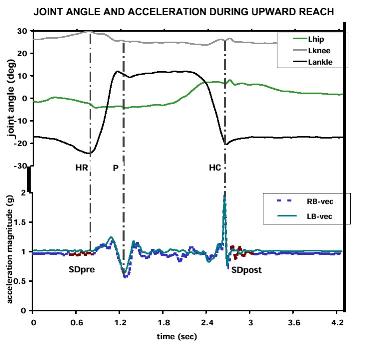
| Home | Publications | Proceedings |
Objectives: Diagnosis of balance disorders can be done by evaluation of an individual's performance in a task intended to stress the postural control system. One common diagnostic task involves reaching toward a target, which requires adjustment of posture prior to and during movement of the arm [Bouisset & Zattara, J Biomechanics, 20: 735-742, 1987]. An example is the Functional Reach test, which is reported to be reliable and valid in predicting falls in an elderly veteran population [Duncan, et al, J Gerontol Med Sci, 47:M93-98, 1992]. In this study, accelerations and joint angles during reaching toward an overhead target were analyzed to identify components of the task most amenable to use as diagnostic measures.
Clinical Relevance: An easy-to-use method of quantifying balance-related upper body motion would enable clinicians to diagnose more subtle disorders of postural neurocontrol and more precise gradations of improvement or worsening of a patient's condition. Wearable self-contained motion sensing apparatus should reduce errors of qualitative judgement during clinical balance assessment, and permit quantitative balance testing in a natural setting.
Methods: Six healthy elders (2 males, 4 females) were asked to reach upwards, rising up on toes, to touch an overhead target placed 3 in. directly above their fingertips when arms were extended upwards using normal stance. Head and trunk motions were recorded using a wearable accelerometric motion analysis system (WAMAS), consisting of two 3-axis sensors on eyeglass frames to measure head motion, and two sensors above each hip on a belt at the waist, along with a self-contained data acquisition package. Joint angles were digitally recorded from electrogoniometers (Biometrix "Penney & Giles") on the left ankle, knee, and hip. Subjects also wore reflective markers for quantitative video analysis.
Comparisons of upward reach motion patterns were made between accelerometric vector magnitudes ("VEC") and electrogoniometric ankle excursions. Three events of upward reach were identified: initial heel raise (HR in figure), peak (P) heel raise, and heel contact (HC). Times between these 3 events were calculated, and plotted motion patterns from VEC and ankle angle data were evaluated.
Results: 3 events (HR, P, HC) could be clearly detected from the VEC vs time curve, and found to consistently coincide with those displayed by the curve of the ankle angle. Initial HR was identified as the first major upward deflection from baseline, signifying a positive acceleration as the body is pushed upwards when the heels are raised. The VEC curve then reverses and approaches its first major minimum at P, when deceleration occurs as the heels are raised to their highest end of the ankle excursion. HC is distinguished as a marked upward deflection, a positive acceleration most clearly seen as a sharp spike when the subject lands hard on the heels, or more subtly when the subject lands softly with more graded control. Repeatable patterns were found between different upward reach trials from the same subject. Timing between the phases of HR, P, and HC were also similar in repeated trials.
Conclusions: Changes in acceleration magnitude patterns correlate with changes in ankle angle, and clearly correspond to detectable events during upward reach. It is possible to identify different strategies that may allude to issues of motor control and balance when performing the fairly destabilizing activity of upward reach. Although upward reaching strategies varied, accelerometric motion patterns were still similar across subjects and events were repeatably identified in the same manner.
Acknowledgments: VA Rehabilitation R&D Merit Review projects E601-2RA, -3RA.